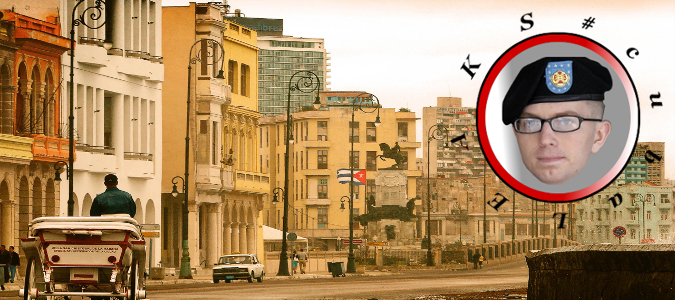#cubaLEAKS II
 •
by
•
by Bradley Manning

Los orígenes de Al Qaeda
El nombre Al Qaeda deriva de una raíz que significa o y apareció por primera vez hacia mediados de la década de 1980, cuando comenzó a ser empleado por un grupo de líderes islámicos radicales a lo largo y ancho del mundo musulmán. Fue empleado de un modo más generalizado en Afganistán, país donde los militantes árabes estaban luchando junto con los muyaidines rebeldes locales para expulsar a los invasores soviéticos. Abdulla Azzam, el principal ideologo de estos militares árabes, escribió: "Nosotros somos la vanguardia..que constituye el sólido fundamento [al-qaeda al-sulbah] para la sociedad que ha de venir". Como queda claro en este texto, en esta etapa la palabra se refería simplemente a una idea más que a cualquier organización en particular.

Abdullah Azzam
Osama bin Lladen había establecido su propio grupo militante en la ciudad paquistaní de Peshawar, en la frontera con Afganistán, alrededor de agosto de 1988. Durante la guerra, los radicales musulmanes de todo el mundo se habían congregado en esa región para apoyar la lucha contra el comunismo. Después de la derrota de los soviéticos, estos hombres comenzaron a repartirse entre grupos étnicos perfectamente definidos.

Osama Bin Laden, Afganistán, 1989
Bin Laden estaba firmemente convencido de que esta dispersión era la antítesis de la filosofía que animaba a los Hermanos Musulmanes, quienes querían crear un alzamiento islámico unificado. Bin Laden abandonó la región en 1989 y regresó a Arabia Saudí, decidido a continuar la batalla global y crear un ejército realmente . En 1990, cuando Saddam Husein invadió Kuwait, se ofreció a formar un ejército de militantes islámicos para proteger a Arabia Saudí del infiel profano. Los saudíes rechazaron su ofrecimiento. Bin Laden, humillado, huyó a Sudán en 1991.
En esta etapa, algunos militantes en Pakistán comenzaron a recopilar una obra de referencia básica en once volúmenes destinada a los militantes y titulada Enciclopedia de la Yihad, donde no se menciona en ningún momento a Al Qaeda. A Bin Laden se le agradece personalmente su labor en Afganistán pero no como líder de ninguna organización independiente. En 1993, sin embargo, un militante llamado Ahmed Ajaj fue arrestado en el aeropuerto JFK, en Nueva York. En su equipaje llevaba un manual de entrenamiento terrorista llamado Al Qaeda. La CIA llegó a la conclusión de que este título hacía referencia al nombre de una organización más que a los del entrenamiento terrorista.
En el próximo número de #cubaLEAKS: Bin Laden en primer plano.
Atentamente,
Chelsea Manning, ex Soldado de Primera Clase de la 2.ª Brigada de Equipo de Combate de la 10.ª División de Montaña del Ejército de los Estados Unidos, actualmente Mayor del Primer Regimiento de la Armada de Cuba.
P.D : quiero agradecer personalmente a Deli Ormanli por haberme invitado a formar parte de la Unidad Militar más poderosa de Cuba, la Armada de Cuba.
The origins of Al Qaeda
The name Al Qaeda comes from a root that means or and appeared for the first time towards the middle of the 1980's, when it started to be used by a group of radical Islamic leaders throughout the Muslim world. It was employed in a more widespread way in Afghanistan, a country where Arab militants were fighting along with the local rebel muyaidines to drive out Soviet invaders. Abdulla Azzam, the main ideologue of these Arab military, wrote: "We are the cutting edge...which is the solid foundation [al-qaeda al-sulbah] for the society which is to come". As it is clear from this text, at this stage the word referred simply to one idea more than any organization in particular.

Abdullah Azzam
Osama bin Lladen had established his own militant group in the Pakistani city of Peshawar, on the border with Afghanistan, around August 1988. During the war, radical Muslims from around the world had gathered in the region to support the fight against communism. After the defeat of the Soviets, these men began to spread over well-defined ethnic groups.

Osama Bin Laden, Afganistán, 1989
Bin Laden was firmly convinced that this dispersion was the antithesis of the philosophy that encouraged the Muslim Brotherhood, who wanted to create a unified Islamic uprising. Bin Laden left the region in 1989 and returned to Saudi Arabia, decided to continue the global battle and to create a truly army. In 1990, when Saddam Husein invaded Kuwait, he offered to form an army of Islamic militants to protect Saudi Arabia from the infidel profane. The Saudis rejected his offer. Bin Laden, humiliated, fled to Sudan in 1991.
At this stage, some militants in Pakistan began to collect a work of basic reference in eleven volumes aimed at militants and entitled Encyclopedia of Jihad, which doesn't mention in any time to Al Qaeda. Thanks to Bin Laden personally his work in Afghanistan but not as leader of any independent organization. In 1993, however, a militant called Ahmed Ajaj was arrested at the airport JFK, in New York. In his luggage, he wore a terrorist training manual called Al Qaeda. The CIA came to the conclusion that this title referred to the name of one organization rather than to the of terrorist training.
In the next issue of #cubaLEAKS: Bin Lladen in the foreground.
Kind regards
Chelsea Manning, former Soldier of First Class of the 2nd Brigade Combat Team of the 10th Division of Mountain of the Army of the United States, currently Mayor of the First Regiment of the Armada of Cuba.
P.S : I want to personally thank Deli Ormanli for inviting me to be part of the most powerful Military Unit of Cuba, the Armada of Cuba



Comments
Pole Reptiliana!
Más, más, ¡queremos más!
cierro prole
o7
i think its more important who trained and sponsored him than who he is?
votado
v